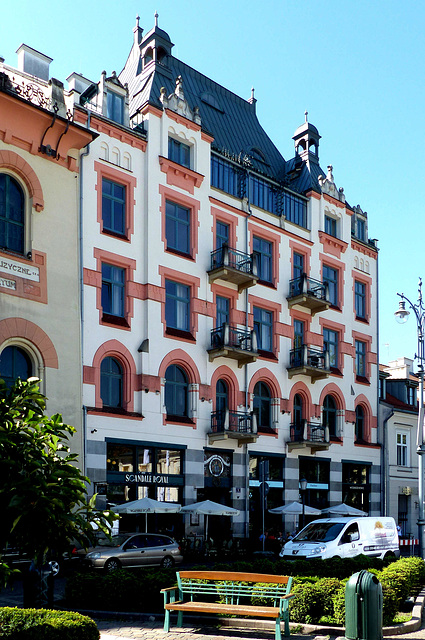Kraków - Plac Szczepański
Kraków - Kolegiata św. Anny
Kraków - Kolegiata św. Anny
Kraków - Barbakan
Kraków - Kościół św. Świętego Krzyża
Kraków - Kościół św. Świętego Krzyża
Kraków - Kościół św. Świętego Krzyża
Kraków - Pod Globusem
Kraków - Plac Nowy
Krakow - Krakowska
Krakow - Stare Mury
Krakow - Bucze
Krakow - Stare Muy
Krakow - Stare Muy
Wysocice - Kościół św. Mikołaja
Wysocice - Kościół św. Mikołaja
Wysocice - Kościół św. Mikołaja
Wysocice - Kościół św. Mikołaja
Wysocice - Kościół św. Mikołaja
Olkusz - Rynek
Olkusz - Bazylika kolegiacka św. Andrzeja Apostoła
Olkusz - Bazylika kolegiacka św. Andrzeja Apostoła
Olkusz - Bazylika kolegiacka św. Andrzeja Apostoła
Kraków - Plac Szczepański
Kraków - Kościół św. Wojciecha
Kraków - Kościół św. Wojciecha
Kraków - Kościół św. Wojciecha
Kraków - Golden Elephant
Kraków - Barbakan
Kraków - Brama Floriańska
Kraków - Synagoga Stara
Kraków - Cmentarz Remuh
Kraków - Bazylika Bożego Ciała
Kraków - Bazylika Bożego Ciała
Kraków - Kościół Bernardynów
Kraków - Kościół Bernardynów
Kraków - Kościół Bernardynów
Kraków - Muzeum Archeologiczne
Kraków - Muzeum Archeologiczne
Kraków - Muzeum Archeologiczne
Kraków - Bazylika św. Franciszka
Kraków - Bazylika św. Franciszka
Kraków - Bazylika św. Franciszka
Kraków - Bazylika św. Franciszka
Kraków - Bazylika św. Franciszka
Location
Lat, Lng:
You can copy the above to your favourite mapping app.
Address: unknown
You can copy the above to your favourite mapping app.
Address: unknown
See also...
Keywords
Authorizations, license
-
Visible by: Everyone -
All rights reserved
-
95 visits
Kraków - Plac Szczepański


A legend attributes Kraków's founding to the mythical ruler Krakus, who built it above a cave occupied by a dragon, Smok Wawelski. The first written record dates to 965, when Kraków was described as a notable commercial center captured by a Bohemian duke Boleslaus I in 955. The first ruler of Poland, Mieszko I, took Kraków from the Bohemians.
In 1038, Kraków became the seat of the Polish government. By the end of the 10th century, the city was a center of trade. Brick buildings were constructed, including the Royal Wawel Castle. The city was sacked and burned during the Mongol invasion of 1241. It was rebuilt and incorporated in 1257 by Bolesław V the Chaste who introduced city rights. In 1259, the city was again ravaged by the Mongols. The third attack in 1287 was repelled thanks in part to the newly built fortifications.
The city rose to prominence in 1364, when Casimir III founded the University of Kraków, the second oldest university in central Europe. But after Casimir´s death in 1370 the campus did not get completed.
As the capital of the Kingdom of Poland and a member of the Hanseatic League, the city attracted craftsmen from abroad, guilds as science and the arts began to flourish. The 15th and 16th centuries are known as Poland's "Złoty Wiek" (Golden Age).
After childless King Sigismund II had died in 1572, the Polish throne passed to Henry III of France and then to other foreign-based rulers in rapid succession, causing a decline in the city's importance that was worsened by pillaging during the Swedish invasion and by an outbreak of bubonic plague that left 20,000 of the city's residents dead. In 1596, Sigismund III of the House of Vasa moved the capital of the Polish–Lithuanian Commonwealth from Kraków to Warsaw.
-
Szczepański Square was established at the beginning of the 19th century after the demolition of two churches.
The square is surrounded by several interesting buildings.
The Art Nouveau tenement house was erected between 1908-1909 according to the design of Wiktor Miarczyński.
In 1038, Kraków became the seat of the Polish government. By the end of the 10th century, the city was a center of trade. Brick buildings were constructed, including the Royal Wawel Castle. The city was sacked and burned during the Mongol invasion of 1241. It was rebuilt and incorporated in 1257 by Bolesław V the Chaste who introduced city rights. In 1259, the city was again ravaged by the Mongols. The third attack in 1287 was repelled thanks in part to the newly built fortifications.
The city rose to prominence in 1364, when Casimir III founded the University of Kraków, the second oldest university in central Europe. But after Casimir´s death in 1370 the campus did not get completed.
As the capital of the Kingdom of Poland and a member of the Hanseatic League, the city attracted craftsmen from abroad, guilds as science and the arts began to flourish. The 15th and 16th centuries are known as Poland's "Złoty Wiek" (Golden Age).
After childless King Sigismund II had died in 1572, the Polish throne passed to Henry III of France and then to other foreign-based rulers in rapid succession, causing a decline in the city's importance that was worsened by pillaging during the Swedish invasion and by an outbreak of bubonic plague that left 20,000 of the city's residents dead. In 1596, Sigismund III of the House of Vasa moved the capital of the Polish–Lithuanian Commonwealth from Kraków to Warsaw.
-
Szczepański Square was established at the beginning of the 19th century after the demolition of two churches.
The square is surrounded by several interesting buildings.
The Art Nouveau tenement house was erected between 1908-1909 according to the design of Wiktor Miarczyński.
kiiti, Paolo Tanino have particularly liked this photo
- Keyboard shortcuts:
Jump to top
RSS feed- Latest comments - Subscribe to the comment feeds of this photo
- ipernity © 2007-2025
- Help & Contact
|
Club news
|
About ipernity
|
History |
ipernity Club & Prices |
Guide of good conduct
Donate | Group guidelines | Privacy policy | Terms of use | Statutes | In memoria -
Facebook
Twitter

Sign-in to write a comment.